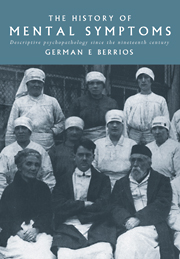Book contents
- Frontmatter
- Contents
- PREFACE
- ACKNOWLEDGEMENTS
- INTRODUCTION
- PART I The object of inquiry
- PART II Cognition and consciousness
- CHAPTER 3 Disorders of perception
- CHAPTER 4 Thought disorder
- CHAPTER 5 Delusions
- CHAPTER 6 Obsessions and compulsions
- CHAPTER 7 Mental Retardation
- CHAPTER 8 Cognitive impairment
- CHAPTER 9 Memory and its disorders
- CHAPTER 10 Consciousness and its disorders
- PART III Mood and emotions
- PART IV Volition and action
- PART V Miscellany
- REFERENCES
- NAME INDEX
- SUBJECT INDEX
CHAPTER 4 - Thought disorder
from PART II - Cognition and consciousness
Published online by Cambridge University Press: 08 January 2010
- Frontmatter
- Contents
- PREFACE
- ACKNOWLEDGEMENTS
- INTRODUCTION
- PART I The object of inquiry
- PART II Cognition and consciousness
- CHAPTER 3 Disorders of perception
- CHAPTER 4 Thought disorder
- CHAPTER 5 Delusions
- CHAPTER 6 Obsessions and compulsions
- CHAPTER 7 Mental Retardation
- CHAPTER 8 Cognitive impairment
- CHAPTER 9 Memory and its disorders
- CHAPTER 10 Consciousness and its disorders
- PART III Mood and emotions
- PART IV Volition and action
- PART V Miscellany
- REFERENCES
- NAME INDEX
- SUBJECT INDEX
Summary
Reports of madmen talking nonsense or reaching weird conclusions are not difficult to find in the literature of the ages. These help if all that the historian wants is to show that the behavioural phenomenon existed before it was considered as a ‘symptom’. It is, however, of less interest if the intention is to write on the history of the concept of thought disorder and on its association with particular diseases. In this regard, the historian must also decide whether ‘thought disorder’ is a unitary construct encompassing analogous forms of talking ‘nonsense’ or just a collection of dissimilar clinical states. Lastly, if a ‘construct’, he must identify the particular theory of thinking on which it has been based.
‘Talking nonsense’ or being ‘thought disordered’ has been predicated of patients making nonsensical claims (delusions), or showing weird usage of words (linguistic mannerisms) or fallacious ways of reaching conclusions (illogicality) or impaired articulation (dysarthria) or paraphrasing or fractured syntax or semantics (aphasia), etc. The clinical separation of these states occurred during the nineteenth century and was as much based on theory as it was on observation; and the most important theoretical frame concerned the relationship between thought and language.
This chapter uses as its search object the current definition of ‘thought disorder’, and accepts the claim that its prototype is seen in schizophrenia. It also accepts the view that clinicians can only ‘observe’ disorganized speech (as per DSM IV); but it also notices that, for the strategy to work, a 1 to 1 correspondence between thought and speech must be assumed.
- Type
- Chapter
- Information
- The History of Mental SymptomsDescriptive Psychopathology since the Nineteenth Century, pp. 71 - 84Publisher: Cambridge University PressPrint publication year: 1996
- 1
- Cited by

